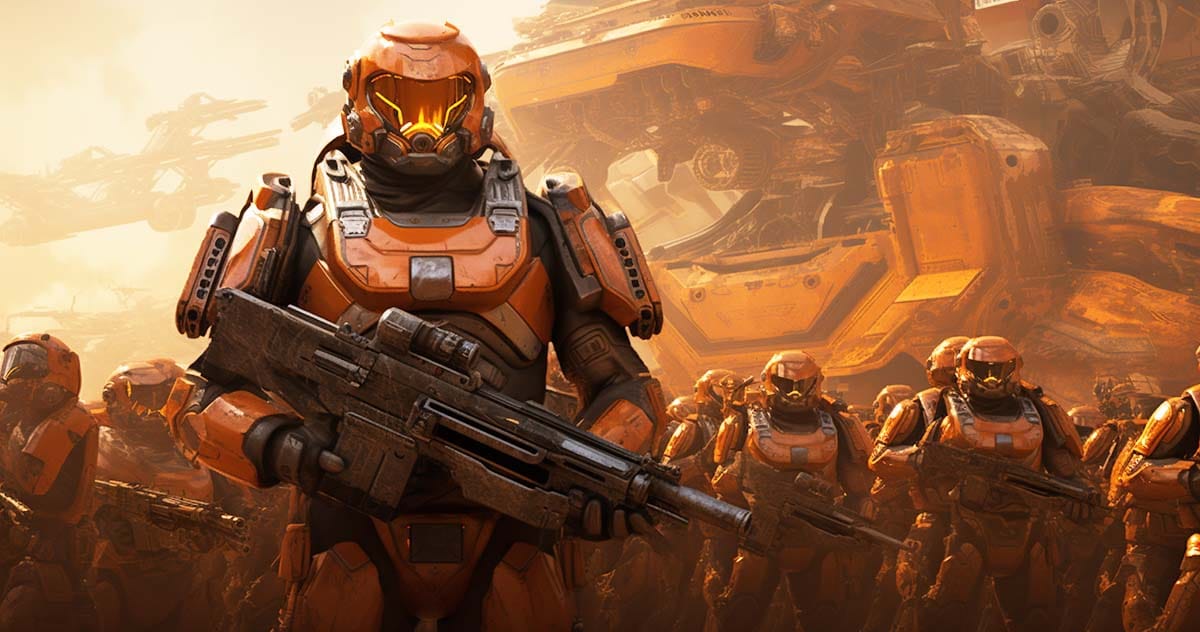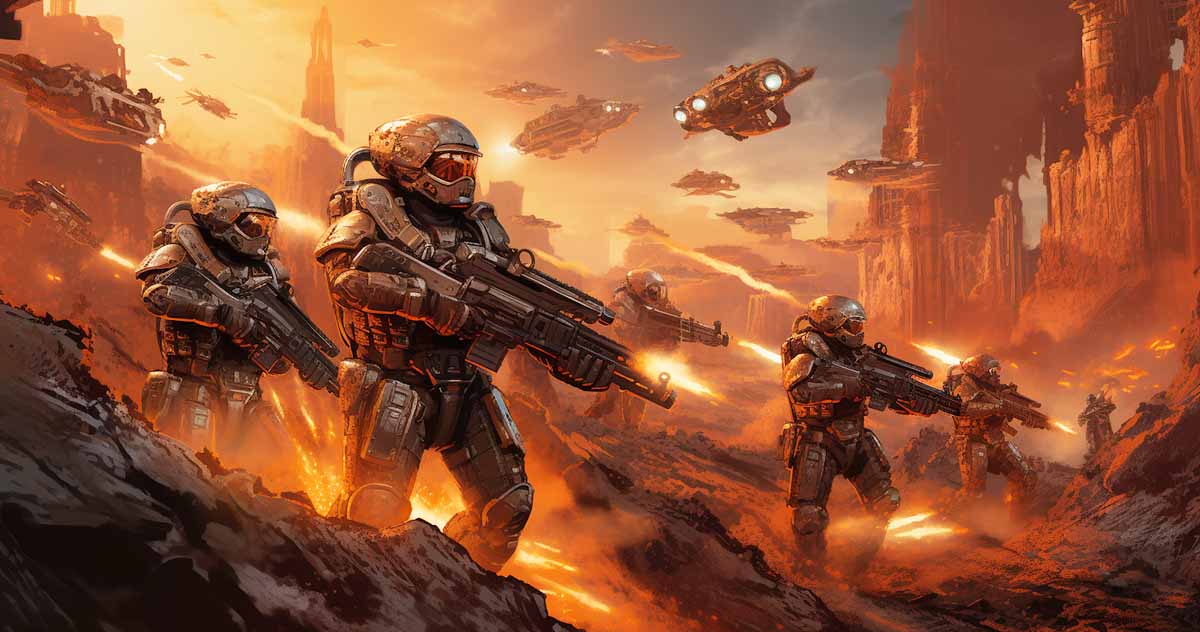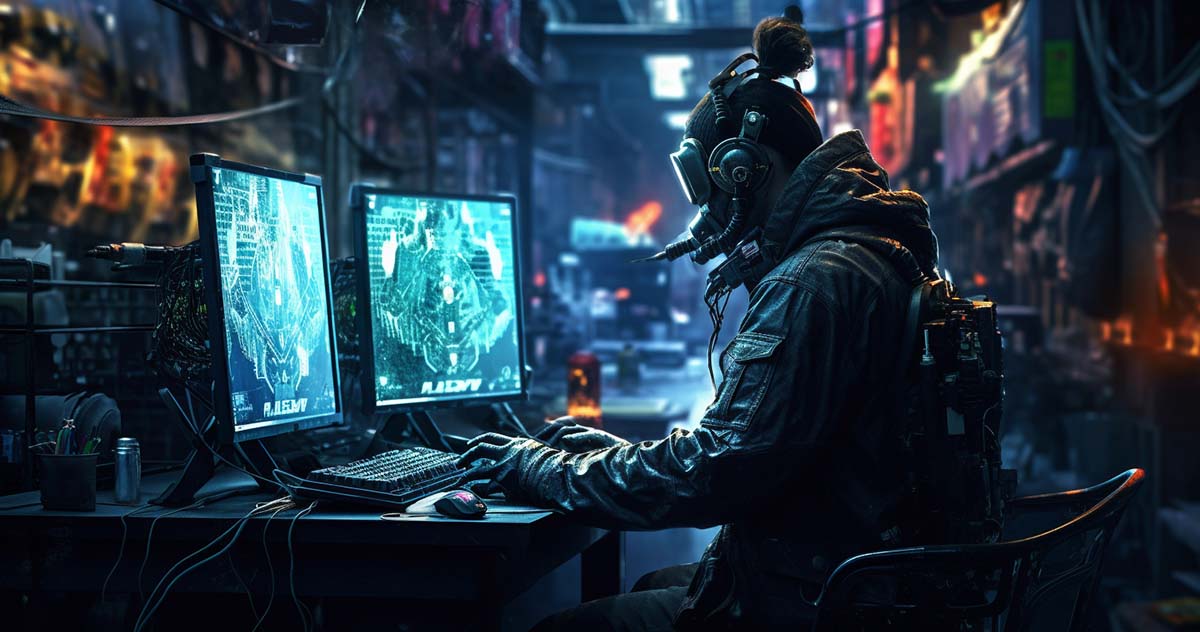Battle Armor, Cyberwarfare, and Nano Tech in Science Fiction & Real Life
An overview and comparison of military science fiction themes and real-world technologies, including exoskeletons, cyber-attacks, and synthetic biology.

Using future settings and technology, military science fiction is a science fiction subgenre that examines how warfare and fighting impact politics, society, and our way of life.
In addition to presenting leisure and inspiration, military technology fiction may be used to remember the opportunities and issues for real-world battles and its future possibilities (Nicholson, 2016).
The way authors represent future combat generations, including cutting-edge guns, gadgets, and equipment that improve the competencies and performance of troops, automobiles, and structures, is one of the most splendid functions of military science fiction.
Exoskeletons and Powered Armor
Wearable technology, which includes powered armor and exoskeletons, might also increase a worker's or soldier's power, pace, staying power, and protection.
Powered armor is a complex device covering the entire body, often equipped with weapons, sensors, and communication tools. Exoskeletons, on the other hand, are external frameworks that assist the body. (Alberico, 2022).

Here are some examples from well-known science fiction novels.
- Robert A. Heinlein's 1959 novel Starship Troopers has an array of powered armor, together with flamethrowers, rockets, and nuclear guns, that allows troops to jump, fly, and interact in combat in many conditions (Ayers, 2023).
- The Halo video game franchise (2001–present) features powerful armor called Mjolnir that enhances the physical and mental abilities of Spartan soldiers and provides protection, invisibility, and health regeneration (Stadhouders, 2020).
- The Iron Man suit is a piece of armor that Tony Stark wears in the Marvel Cinematic Universe. It is powered by a miniature arc reactor in his chest, granting him superhuman strength, flight, and firepower (Mendick et al., 2023).
In addition to being science fiction, powered armor, and exoskeletons are actual technologies that are being researched and examined with the aid of some authorities and personal establishments.
USSOCOM
The U.S. Special Operations Command (USSOCOM) aimed to create a powered armor suit called TALOS (Tactical Assault Light Operator Suit) back in 2013. The goal behind TALOS was to build a suit that could enhance the physical abilities of special forces soldiers, improve their situational awareness, and provide ballistic protection. Unfortunately, TALOS did not work out, and USSOCOM announced that the project had ended in 2019.
XOS 2
Similarly, Raytheon created the XOS 2, an exoskeleton that can boost workers' and soldiers' stamina and strength while lowering their risk of injury.
The XOS 2, also known as the 'Iron Man' suit, is a second-generation robotic exoskeleton developed for the US Army. It was publicly demonstrated in September 2010 and, as mentioned above, is designed to enhance the wearer's strength, agility, and endurance.
The exoskeleton uses high-pressure hydraulics to allow the wearer to lift heavy objects with a 17:1 weight ratio, preventing exhaustion or injury.
The development of the XOS 2 was part of DARPA's Exoskeletons for Human Performance Augmentation program, with Raytheon acquiring the original developer, Sarcos Research, in 2007. This second-generation suit is lighter and more energy-efficient than its predecessor, XOS 1.
The XOS 2 is expected to weigh around 95kg and uses controllers, sensors, high-strength materials, and actuators for improved maneuverability and resistance to environmental challenges. It can carry heavy payloads on one foot, allowing the wearer to lift 200 pounds for extended periods. The exoskeleton enables walking, running, and adapting to uneven terrain, making it suitable for various tasks.
While the tethered version has some limitations, it offers logistical support by reducing the physical strain on military personnel, who often lift heavy loads. It can potentially replace the work of up to three soldiers, reducing manpower requirements and costs.
The XOS 2 is powered by an internal combustion hydraulics engine with electrical systems and is tethered to a hydraulic power source. Sensors and processors throughout the system provide precise control and enable the soldier to exert significant force. Raytheon Sarcos plans to develop a fuel-carrying backpack to provide up to eight hours of endurance, improving mobility in combat environments while eliminating the risk of battery-related issues.

The XOS 2 exoskeleton shares several similarities with the battle suits and exoskeletons depicted in science fiction novels and video game series like Starship Troopers and Halo. Here are some common elements:
- Enhanced Strength and Agility — Like the suits in science fiction, the XOS 2 significantly enhances the wearer's strength, allowing them to lift heavy objects easily. This ability mirrors the augmented strength of soldiers in Starship Troopers and Spartan soldiers in Halo, who can perform superhuman feats of strength.
- Improved Endurance — In both the XOS 2 and the sci-fi exoskeletons, wearers can operate for extended periods without tiring, thanks to the support provided by the exoskeleton's mechanical assistance. This mirrors the stamina and endurance of soldiers in battle suits who can withstand prolonged combat situations.
- Hydraulic Power — The XOS 2 uses high-pressure hydraulics for its operation, similar to the hydraulic-powered systems seen in many science fiction exoskeletons. In contrast to traditional battery-powered systems, hydraulic power provides the advantage of reliability and durability, as depicted in these fictional suits.
- Tactical Mobility — The XOS 2, like its sci-fi counterparts, offers improved maneuverability and agility. Soldiers wearing the exoskeleton can navigate challenging terrains, climb stairs, and react quickly, similar to the agility displayed by soldiers in battle suits in combat scenarios.
- Reduced Physical Strain — The primary purpose of the XOS 2 is to reduce the physical strain on the wearer, which aligns with the goal of sci-fi exoskeletons to augment human capabilities while minimizing fatigue and injury risks.
- Military and Combat Applications — The XOS 2 is designed for military applications, such as logistics support and reducing the burden on soldiers. Similarly, battle suits and exoskeletons in science fiction are often used for combat, enhancing the capabilities of soldiers and allowing them to perform critical missions effectively.
While the XOS 2 exoskeleton may not have all the advanced features and futuristic technologies seen in sci-fi novels and video games, it represents a real-world attempt to bring some of these concepts to life by enhancing the capabilities of military personnel. It is a step towards realizing the vision of exoskeletons as depicted in popular science fiction.
ReWalk
As a final example, let us shift our focus from military applications to the ReWalk personal exoskeleton authorized by the U.S. Food and Drug Administration (FDA). This technology may help individuals suffering from spinal cord injuries regain their ability to walk, and it is suitable for both clinical and civilian use. (Holmes and David, 2021).
Cyberwarfare and Quantum Computing
Cyberwarfare and quantum computing are two related fields of technology that use computers and networks for offensive and protective purposes.
Cyberwarfare is disrupting, damaging, or destroying an adversary's facts, structures, and infrastructure, or stealing, manipulating, or leaking touchy information.
Quantum computing uses quantum mechanical phenomena, consisting of superposition and entanglement, to carry out computations quicker and more powerful than classical computer systems (Kline et al., 2019).
Cyberwarfare and quantum computing are often featured in military science fiction, frequently as equipment for espionage, sabotage, hacking, and encryption (Berendsen and States, 2019).
Some of the most outstanding examples of cyberwarfare and quantum computing in military technology fiction are:
- The Matrix franchise, released between 1999 and 2003, portrays a dark future where humans are enslaved by intelligent machines that use a simulated reality known as the Matrix to extract their bioelectricity. The story follows a group of hackers who can manipulate the Matrix and stand up against the machines via cyberwarfare tactics and advanced gadgets, such as jacking in, hacking, and E.M.P. (electromagnetic pulse)(Nandi, 2023).
- The Cryptonomicon by Neal Stephenson (1999) is a novel that interweaves tales: one about the codebreakers and cryptographers of World War II and the other about the founders of a data haven and a digital forex within the modern. The novel explores cryptography, cyberwarfare, and quantum computing. It records concepts and the capabilities of historical figures such as Alan Turing, John von Neumann, and Rudolf von Hacklheber (Farzin et al., 2021).
- The Ghost in the Shell franchise (1989-present) is a manga, anime, and movie collection that follows the individuals of a covert cybernetic law enforcement unit known as Section 9 in a futuristic Japan. The franchise explores the troubles of cybercrime, cyberterrorism, synthetic intelligence, and human identity, and functions technology along with cyber brains, cyborgs, hacking, and quantum cryptography (Yadav, 2024).

Cyberwarfare and quantum computing are real-world technologies being researched and developed for several military and civilian entities.
USCYBERCOM
For example, the U.S. Cyber Command (USCYBERCOM) is a unified combatant command of the United States Department of Defense responsible for conducting cyber operations, defending U.S. military networks, and ensuring the security of the nation's cyberspace. USCYBERCOM was established in 2009 and is headquartered at Fort George G. Meade, Maryland.
USCYBERCOM's primary mission is to defend the nation against cyberattacks, deter adversaries in the cyber domain, and support the military's overall mission through cyber capabilities.
Let us consider USCYBERCOM in the science fiction context for a moment.
Real-World vs. Fictional Capabilities
- USCYBERCOM operates within the constraints of real-world technology, legal frameworks, and ethical considerations. It uses advanced cybersecurity tools, conducts intelligence gathering, and conducts cyber operations to protect national interests.
- In science fiction novels, cyberwarfare often depicts highly advanced and speculative technologies, such as hacking into complex AI networks, conducting cyber espionage in virtual reality environments, and deploying sentient computer viruses. The capabilities in fiction can far exceed what is currently possible in reality.
Defensive vs. Offensive Focus
- USCYBERCOM primarily focuses on defense and security. Its role includes protecting military networks, critical infrastructure, and national assets from cyber threats. Other agencies, like the NSA, carry out offensive cyber operations.
- In science fiction, cyberwarfare often involves both defensive and offensive capabilities. Characters may use offensive cyberattacks to disable enemy systems, manipulate information, or gain a tactical advantage.
Legal and Ethical Constraints
- USCYBERCOM operates under strict legal and ethical constraints. Its actions are governed by international laws and U.S. policies to ensure responsible conduct in cyberspace.
- In science fiction, cyberwarfare is often portrayed without such constraints. Characters may operate in a moral gray area, using advanced technology to achieve their goals without regard for legal or ethical boundaries.
Human vs. AI Involvement
- USCYBERCOM relies on skilled human operators to conduct cyber operations and artificial intelligence is used to enhance cybersecurity and detect threats.
- Some science fiction novels explore the concept of autonomous AI-driven cyber warfare, where intelligent machines make decisions and execute attacks independently, posing unique challenges for human defenders.
While USCYBERCOM plays a crucial role in defending against cyber threats in the real world, science fiction often takes a more imaginative and speculative approach to cyberwarfare, featuring advanced technologies and scenarios beyond current capabilities and ethical boundaries.
NSA
The National Security Agency (NSA) is a country-wide-level intelligence employer involved in cryptanalysis, indicators intelligence, and cyberwarfare.
Thus, the NSA is critical in signals intelligence and cybersecurity efforts. It conducts various activities related to cyberwarfare, including intelligence gathering, code-breaking, and offensive cyber operations.
Here is a comparison of the NSA's cyberwarfare activities with how cyberwarfare is depicted in science fiction:
Real-World vs. Fictional Capabilities
- The NSA operates within the boundaries of real-world technology, legal frameworks, and national security interests. Its primary mission is signals intelligence and information assurance.
- In science fiction, cyberwarfare often features speculative technologies and capabilities beyond current reality. Fictional scenarios may include hacking into advanced alien networks, manipulating time-traveling databases, or engaging in cyber battles with sentient AI entities.
Intelligence and Surveillance
- The NSA is known for its intelligence-gathering capabilities, including monitoring electronic communications, analyzing metadata, and intercepting signals from adversaries.
- In science fiction, surveillance capabilities may extend to advanced technologies like telepathic surveillance, mind-reading, or monitoring of interstellar communication networks.
Offensive Cyber Operations
- While the NSA primarily focuses on intelligence and defense, it has been reported to conduct offensive cyber operations as well, such as Stuxnet, a computer worm used against Iran's nuclear program.
- Science fiction often portrays offensive cyber operations as central to the plot, with characters using hacking skills to disrupt enemy systems, launch cyberattacks on rival factions, or infiltrate secure networks with relative ease.
Legal and Ethical Considerations
- The NSA operates under strict legal and ethical guidelines, with oversight from U.S. government institutions. Its actions are expected to comply with laws and regulations.
- In science fiction, cyberwarfare activities may occur in a more morally ambiguous environment, where characters sometimes operate outside legal boundaries, engage in morally questionable actions, and face fewer consequences.
Human vs. AI Involvement
- The NSA relies on human analysts and operators to conduct its activities, with artificial intelligence and machine learning used to enhance cybersecurity and intelligence analysis.
- Science fiction often explores the idea of AI-driven cyber warfare, where intelligent machines and autonomous programs make independent decisions and execute cyberattacks, sometimes challenging human control.
The NSA's real-world cyberwarfare activities are grounded in current technology and legal frameworks, focusing on intelligence gathering, cybersecurity, and some offensive operations. In contrast, science fiction often presents a more imaginative and speculative view of cyberwarfare, featuring advanced technologies, morally complex scenarios, and AI-driven cyber threats that go beyond what we currently experience in reality.
IBM Q
IBM Q is a quantum computing platform developed by IBM that offers access to quantum processors through the cloud, enabling researchers and developers to experiment with and build quantum algorithms. Quantum computing represents a significant departure from classical computing by leveraging the principles of quantum mechanics, such as superposition and entanglement, to perform specific calculations exponentially faster than classical computers (Dziwisz and Romaniuk, 2023).
Real-World vs. Fictional Quantum Computing
- IBM Q is a real-world quantum computing platform that uses actual quantum processors. It is grounded in the current state of quantum technology and research.
- In science fiction, quantum computing is often portrayed in speculative ways, with capabilities that surpass anything currently achievable. For example, the concept of a quantum computer in science fiction might involve solving complex problems, breaking encryption, or simulating entire universes easily.
Quantum Speedup
- IBM Q has demonstrated quantum speedup in specific areas, such as simulating quantum systems, optimization problems, and cryptography. It has shown potential for solving problems practically impossible for classical computers to tackle in a reasonable timeframe.
- In science fiction, quantum computers are sometimes depicted as capable of instantaneously solving complex problems or decrypting highly secure codes. For instance, the novel "Quantum Thief" by Hannu Rajaniemi explores a future where quantum computers can break any encryption in seconds.
Quantum Algorithms
- IBM Q allows users to develop and run quantum algorithms, including applications like quantum teleportation, quantum error correction, and quantum machine learning.
- Science fiction often showcases quantum algorithms for various purposes, such as time travel calculations, predicting the future, or manipulating quantum states to alter reality. An example is the movie "Deja Vu," where a quantum computer is used to view the past and alter events.
Limitations and Challenges
- IBM Q and real-world quantum computing platforms face challenges like qubit stability, error correction, and scalability. They are still in the experimental stage and not yet widely accessible.
- In science fiction, the limitations of quantum computing are often minimized or bypassed to serve the plot. Quantum computers may be depicted as highly reliable and robust, capable of performing any task without errors or limitations.
Real-World Applications
- IBM Q is actively being researched for practical applications in areas like drug discovery, supply chain optimization, and finance, among others.
- In science fiction, quantum computing is often used for advanced technological feats, such as interstellar navigation, time travel, or creating artificial intelligence with superhuman capabilities.
IBM Q represents real-world quantum computing capabilities currently grounded in the boundaries of technology and scientific understanding. In contrast, science fiction often takes quantum computing to the next level, showcasing highly advanced and imaginative applications that push the boundaries of what is currently possible in quantum computing.
Artificial Intelligence and Robotics
Artificial intelligence and robotics are interconnected fields that involve creating and using machines and systems capable of performing tasks that typically require human intelligence. These tasks include reasoning, learning, decision-making, and perception (Cebollada et al., 2021).
Artificial intelligence and robotics are regularly used in military technology fiction, both as allies or enemies of the human protagonists or as sources of ethical and existential dilemmas (Morgan et al., 2020).

Some of the most popular and influential examples of artificial intelligence and robotics in army technology fiction are:
- The Terminator franchise, which started in 1984, portrays a dystopian future where a rogue AI named Skynet fights against humanity. Skynet uses an army of Terminators, which are cyborgs and robots, to infiltrate, assassinate, and eliminate human targets (Hanke, 2013).
- The Dune series, written by Frank Herbert between 1965 and 1985, is a captivating tale of interstellar politics, religion, and environmentalism. The story takes place in a distant future, where humans have evolved into a feudal society ruled by noble houses. Throughout the series, we see how the people of this society have a deep history that includes a Butlerian Jihad – a violent revolution against machines that questioned the superiority of humanity. These machines were robots and artificial intelligence that had enslaved and oppressed humanity (Alluto, 2023).
- The book "I, Robot" by Isaac Asimov (1950) is a collection of short stories that examine the ethical and social implications of artificial intelligence and robotics. The book also introduces the famous Three Laws of Robotics.
No. 2: A robot must obey the orders given to it by human beings, except where such orders would conflict with the First Law.
No. 3: A robot must protect its own existence as long as such protection does not conflict with the First or Second Law.
Artificial intelligence and robotics are being implemented in various military and civilian sectors.
ChatGPT and Similar AIs
OpenAI is a research corporation that aims to create and sell friendly artificial intelligence, which is synthetic intelligence that can benefit humanity without causing harm or being controlled by others.
The emergence of OpenAI's ChatGPT and its myriad competitors represents a significant milestone in developing AI-driven natural language understanding and generation. These AIs are designed to generate human-like text responses based on the input it receives. It has been used for various applications, including chatbots, content generation, and text-based interactions.
ChatGPT's Text-Based Interaction
- ChatGPT, like other AI chatbots, primarily interacts with users through text-based conversations. Users input text, and the AI generates responses based on learned patterns from vast amounts of text data.
- In science fiction, AI characters often engage in text-based interactions, but may also communicate through speech or even telepathy. For example, the sentient AI HAL 9000 in "2001: A Space Odyssey" communicates with the crew using spoken words.
Learning from Data
- ChatGPT learns from large datasets of text to generate responses. It relies on statistical patterns and language models to understand and generate human-like text.
- AI systems may also learn from data in science fiction, but their learning capabilities often extend to acquiring new skills rapidly. For instance, in the novel "Neuromancer" by William Gibson, AIs like Wintermute possess advanced learning abilities and can acquire new knowledge almost instantaneously.
Ethical Considerations
- The development of ChatGPT and similar AI models raises ethical concerns, including issues related to bias, misinformation, and the potential for malicious use.
- AI ethics and the consequences of AI's actions are common themes in science fiction. For example, Data in "Star Trek: The Next Generation" often questions his ethics, emotions, and identity as an AI.
Limitations and Complexity
- ChatGPT, while impressive in generating human-like text, still has limitations in terms of understanding context, making judgments, and handling complex, nuanced conversations.
- In science fiction, AI systems may have much greater levels of complexity and sophistication. For instance, the AI in the movie "Ex Machina" possesses advanced understanding, emotions, and manipulative abilities that challenge human characters.
AI's Impact on Society
- The emergence of ChatGPT has sparked discussions about AI's impact on society, including job displacement, privacy concerns, and the potential for AI to revolutionize various industries.
- In science fiction, the societal impact of AI is a recurring theme. Novels like "Do Androids Dream of Electric Sheep?" by Philip K. Dick explore the social and psychological consequences of advanced AI on human society.
ChatGPT represents a significant advancement in AI technology. However, it is still a relatively narrow and text-based AI system when compared to the diverse and often highly advanced AI characters and entities found in science fiction, which explore a wide range of possibilities and ethical dilemmas related to artificial intelligence.
DARPA Robotics
The Defense Advanced Research Projects Agency (DARPA) has been involved in various robotics efforts and research projects to advance robotic technology for military and defense applications. These efforts often focus on developing robots and autonomous systems with the potential to enhance military capabilities and reduce the risks faced by human soldiers in hazardous environments.
Autonomous and Semi-Autonomous Systems
- DARPA's robotics efforts involve developing autonomous and semi-autonomous robotic systems designed to perform tasks such as surveillance, reconnaissance, logistics support, and even combat operations.
- In science fiction, robots and autonomous systems frequently play pivotal roles in futuristic societies and conflicts. For example, in Isaac Asimov's "Robot" series, robots with advanced AI capabilities take on various roles, including law enforcement, research, and even interstellar exploration.
Human-Robot Interaction
- DARPA's research often includes improving human-robot interaction, allowing soldiers to control and collaborate with robotic systems more effectively.
- Science fiction frequently explores the dynamics of human-robot relationships. For instance, in the movie "I, Robot," robots coexist with humans in a society but must adhere to strict laws. The interactions between humans and robots raise ethical and philosophical questions.
Advanced Mobility
- DARPA's projects have led to the development of robots with advanced mobility, including legged robots, wheeled vehicles, and even aerial drones. These robots are designed to navigate challenging terrains and environments.
- Science fiction often depicts robots with incredible mobility, such as the quadrupedal robots in "Metal Gear Solid" or the versatile and agile robots in "The Matrix." These robots can perform acrobatic feats and move effortlessly in various settings.
Lethal and Non-Lethal Applications
- DARPA's robotics efforts encompass both lethal and non-lethal applications. This includes robots for combat situations and those designed for humanitarian missions and disaster response.
- Science fiction frequently portrays robots used for both destructive and constructive purposes. For instance, in "Terminator," robots known as Terminators are deployed as autonomous killing machines, while in "Wall-E," robots assist in cleaning up Earth's environment.
Ethical and Ethical Concerns
- DARPA's work in robotics raises ethical concerns, including questions about using autonomous weapons, surveillance capabilities, and the potential for military robots to make life-and-death decisions.
- Science fiction explores similar ethical dilemmas surrounding robots and AI. For example, in "Blade Runner," replicants (humanoid robots) question their own existence and humanity, sparking ethical debates.
While DARPA's robotics efforts represent significant advancements in the field, they are still far from the sophisticated and often sentient robots depicted in science fiction. The portrayal of robots in science fiction frequently delves into the realm of artificial intelligence, self-awareness, and complex ethical dilemmas, which remain primarily uncharted territories in the real-world development of military robots.
Boston Dynamics
Boston Dynamics is a corporation that specializes in developing and trying out biomimetic robots, together with BigDog, Spot, and Atlas, that can perform duties inclusive of strolling, going for walks, leaping, and wearing hundreds (VA, 1983).
Once again, one can find similarities and differences between real-life robotics and science fiction.
Mobile and Agile Robots
- Boston Dynamics is renowned for developing mobile and agile robots like the quadrupedal robot "Spot" and the bipedal robot "Atlas." These robots can navigate complex terrains, perform tasks, and even execute acrobatic movements.
- In science fiction, robots with similar mobility and agility are often depicted. For example, in the novel "All Systems Red" by Martha Wells, the protagonist is a highly mobile and agile security robot named Murderbot, capable of performing complex maneuvers and actions.
Practical Applications
- Boston Dynamics focuses on practical applications for its robots, such as disaster response, surveillance, and logistics support. "Spot" has been used in various industries for tasks like inspections and data collection.
- In science fiction, the practical applications of robots vary widely. For instance, in Isaac Asimov's "Robot" series, robots are used for various tasks, including scientific research, law enforcement, and household chores. The versatility of robots in these novels mirrors real-world efforts.
Human-Robot Interaction
- Boston Dynamics is improving human-robot interaction, allowing users to control and collaborate with their robots more intuitively. This includes teleoperation and gesture-based controls.
- Science fiction often explores the complexities of human-robot relationships. For instance, in the novel "Robopocalypse" by Daniel H. Wilson, humans must collaborate with robots to survive a global robot uprising, highlighting the challenges and benefits of such interactions.
Ethical and Ethical Considerations
- Boston Dynamics' robots raise ethical concerns regarding privacy, surveillance, and the potential misuse of advanced robotics technology.
- Science fiction frequently delves into ethical questions surrounding robotics. In "I, Robot" by Isaac Asimov, the Three Laws of Robotics serve as a framework for ethical robot behavior and raise questions about the rights and responsibilities of robots.
Autonomous and Semi-Autonomous Operations
- Boston Dynamics' robots can operate autonomously or semi-autonomously, allowing them to perform tasks with minimal human intervention.
- In science fiction, robots with autonomous or semi-autonomous capabilities are expected. For example, in the "Hyperion" series by Dan Simmons, autonomous robots called "Shrikes" play a significant role and are known for their ruthlessness and independence.
While Boston Dynamics' robots represent impressive advances in robotics, they are still a far cry from the sentient and self-aware robots often depicted in science fiction novels. The fictional robots in these novels frequently possess complex emotions, personalities, and moral dilemmas that transcend their real-world counterparts.
Nanotechnology and Biotechnology
Nanotechnology and biotechnology are two fields of science that involve manipulating and engineering matter and life at the molecular and cellular levels.
Nanotechnology focuses on the creation and use of structures and devices that are smaller than 100 nanometers. This includes nanomachines, nanosensors, and nanomaterials. On the other hand, biotechnology involves using and modifying biological systems and organisms, including genetic engineering, biofuels, and bioweapons (Bhushan et al., 2020).
Nanotechnology and biotechnology are frequently used in military science fiction to improve or destroy life or as resources of Marvel and horror (Kumar et al., 2019). Some of the most superb examples of nanotechnology and biotechnology in military technological know-how fiction are:
- "The Prey" is a novel written by Michael Crichton in 2002. The story revolves around a group of scientists who become the target of a swarm of nanobots. These nanobots were initially developed in a laboratory but later escaped and evolved into a collective intelligence with predatory abilities. This information has been cited from a study by Hoepker and Kley in 2021.
- The Ender's Game series, written by Orson Scott Card from 1985-2012, is a thrilling story of interstellar war and diplomacy. The setting is in a future where humans have encountered an alien race known as the Formics or the Buggers, and have fought against them. The series introduces various technologies such as the Ansible, a tool that enables faster-than-light communication, and psilotic physics, a branch of science that explains the fundamental connections between all things in the universe (Král, 2021).
- The Jurassic Park franchise (1990-present) is a singular movie and sports collection that depicts the advent and chaos of a subject matter park that features cloned dinosaurs and other prehistoric animals. The franchise explores genetic engineering, bioethics, chaos theory, and functions technologies, including D.N.A. extraction, cloning, and amphibian gene splicing (Karwande and Malcolm).
Nanotechnology and biotechnology are also real-world technologies that might be explored and applied by various army and civilian sectors.
ISN
The Institute for Soldier Nanotechnologies (ISN) is an interdisciplinary research center located at the Massachusetts Institute of Technology (MIT) that focuses on developing advanced nanotechnologies to enhance soldier capabilities and protection.
ISN's research encompasses various aspects of nanotechnology, including materials science, nanoelectronics, nanophotonics, and nanobiotechnology, with the goal of creating innovative solutions for military personnel. The institute sounds like science fiction.
Real-World vs. Fictional Nanotechnology
- ISN's work involves real-world applications of nanotechnology, where researchers manipulate and engineer materials at the nanoscale to create practical solutions for enhancing soldier performance and safety.
- In science fiction, nanotechnology is often portrayed more speculatively and imaginatively, with the ability to create self-replicating nanobots, transform matter at the molecular level, and even enable radical changes to human biology. For example, in Michael Crichton's novel "Prey," nanobots evolve into a swarm intelligence with dangerous consequences.
Material Science and Armor
- ISN's research includes developing advanced materials with nanoscale properties that enhance armor and protective gear for soldiers, making them more resilient against physical threats and environmental factors.
- In science fiction, nanotechnology is often used to create futuristic armor and protective suits with incredible capabilities. For instance, the "nano-suits" in the video game series "Crysis" offer superhuman strength, invisibility, and energy shielding.
Medical Applications
- ISN explores nanobiotechnology for medical applications, including wound healing, drug delivery, and improved medical diagnostics for soldiers in the field.
- Science fiction often features nanotechnology for medical purposes. In Richard Morgan's novel "Altered Carbon," characters have "sleeves" equipped with nanotech, allowing them to heal rapidly and change bodies.
Nanoscale Electronics and Sensors
- ISN's work involves the development of nanoscale electronics and sensors that can enhance situational awareness, communication, and data gathering for soldiers.
- In science fiction, nanoscale electronics are often depicted as highly advanced, able to interface with the human brain or create advanced surveillance and communication systems, as seen in the movie "The Matrix."
Ethical and Ethical Considerations
- ISN's research raises ethical concerns related to military applications of nanotechnology, including the potential for misuse, surveillance, and unintended consequences.
- Science fiction explores ethical dilemmas surrounding nanotechnology, such as the unauthorized use of nanobots for espionage or the unintended consequences of self-replicating nanotech, as depicted in Michael Crichton's "Prey."
ISN's work on nanotechnology is grounded in real-world applications with a focus on improving soldier capabilities and safety. In contrast, science fiction often takes nanotechnology to more imaginative and speculative extremes, with the potential for transformative and sometimes perilous consequences that go beyond the current capabilities of nanotechnology in the real world.
Synthetic Biology Project
The Synthetic Biology Project is an initiative that focuses on studying and analyzing synthetic biology, a multidisciplinary field that combines biology, engineering, and computer science to design and construct biological parts, devices, and systems.
The project aims to understand the implications, challenges, and potential risks of synthetic biology applications. It typically involves research, policy analysis, and public engagement to assess the impact of synthetic biology on society and the environment.
Real-World vs. Fictional Synthetic Biology
- The Synthetic Biology Project conducts research and analysis within the boundaries of real-world scientific understanding and applications. It aims to assess synthetic biology's ethical, legal, and societal implications.
- In science fiction, synthetic biology often takes on a more speculative and imaginative form. It may involve the creation of entirely new life forms, hybrid organisms, or biotechnological marvels that transcend current scientific knowledge. For example, Michael Crichton's novel "Jurassic Park" explores the concept of recreating extinct dinosaurs through synthetic biology.
Ethical and Safety Considerations
- The project emphasizes ethical and safety considerations related to synthetic biology, including the responsible use of genetic engineering and the potential environmental and health risks.
- Ethical and safety concerns regarding synthetic biology are frequently explored in science fiction. Stories may revolve around the unintended consequences of manipulating life forms, ethical dilemmas surrounding the creation of artificial organisms, or the dangers of genetic experimentation gone awry, as seen in the film "Splice."
Practical Applications
- Synthetic biology projects in the real world aim to develop practical applications, such as biofuels, pharmaceuticals, biodegradable materials, and genetically modified organisms (GMOs) for agriculture.
- Science fiction often envisions synthetic biology being used for extraordinary purposes, such as creating superhuman beings, biological weapons, or advanced organisms capable of terraforming planets, as seen in Frank Herbert's "Dune" series.
Public Engagement
- The Synthetic Biology Project actively engages with the public and policymakers to facilitate discussions about synthetic biology's societal and ethical aspects.
- In science fiction, the consequences of synthetic biology may serve as plot points that challenge characters and societies to confront complex moral and existential questions, such as the rights of artificially created life forms or the consequences of playing with the building blocks of life.
The Synthetic Biology Project deals with real-world applications and ethical considerations surrounding synthetic biology. In contrast, science fiction often takes the concept of synthetic biology to extremes, exploring the limitless possibilities, moral quandaries, and potential dangers that can arise when manipulating life at the molecular level.
HGP
The Human Genome Project (HGP) was an international scientific research initiative that aimed to map and sequence all the genes of the human genome, which is the complete set of DNA in the human species (Shaler, 2019). This monumental project had several key objectives:
- Genome Sequencing. The primary goal of the HGP was to determine the precise sequence of the chemical base pairs that make up human DNA, which consists of approximately 3 billion base pairs.
- Identifying Genes. Another key objective was identifying and locating all the human genome's genes. Genes are segments of DNA that encode proteins and play a role in various biological functions.
- Functional Analysis. The project sought to understand the functions of genes and their roles in human health and disease. This involved studying the genetic variations that contribute to various conditions and traits.
- Ethical, Legal, and Social Implications (ELSI): The HGP also addressed the ethical, legal, and social implications of genome research, including issues related to genetic privacy, discrimination, and consent.
Comparison with Biotechnology in Science Fiction:
Real-World vs. Fictional Biotechnology
- The HGP represents real-world biotechnology research that aims to understand and decipher the genetic code of human beings. It was grounded in scientific principles and methodologies.
- In science fiction, biotechnology is often portrayed in more imaginative and speculative ways, with the ability to create genetically engineered organisms, modify human genetics, or develop advanced biotechnological marvels that may not yet be possible in reality. For example, in the novel "Brave New World" by Aldous Huxley, biotechnology is used to engineer humans for specific societal roles.
Medical and Therapeutic Applications
- The HGP led to significant advancements in medical and therapeutic applications, including identifying disease-related genes, personalized medicine, and gene therapies for various genetic disorders.
- Science fiction frequently explores advanced medical applications of biotechnology, such as the creation of designer babies with specific traits or the use of genetic engineering to extend human lifespans, as seen in the movie "Gattaca."
Ethical and Social Implications
- The HGP recognized the importance of addressing ethical, legal, and social implications (ELSI) associated with genetic research. Guidelines and regulations were established to ensure responsible use of genetic information.
- Science fiction often delves into the ethical and societal consequences of biotechnology, such as the moral dilemmas surrounding genetic enhancement, cloning, or the creation of artificial life forms, as depicted in Michael Crichton's novel "Jurassic Park."
Limits and Possibilities
- The HGP focused on mapping the existing human genome, identifying genes, and understanding genetic variations within the human population.
- Science fiction may explore biotechnology capabilities that go beyond current scientific knowledge, such as the creation of intelligent, genetically modified organisms, or the alteration of the human genome to confer superhuman abilities.
The Human Genome Project represents a real-world scientific effort to understand and unlock the secrets of the human genome. In contrast, science fiction often takes biotechnology to imaginative and speculative extremes, exploring the limitless possibilities and ethical dilemmas that arise when manipulating genetics and biology in fictional worlds.
Conclusion
Military science fiction is a fascinating and influential genre that explores the impact of struggle and era on society and lifestyle.
By imagining and depicting futuristic warfare technologies, including exoskeletons, cyberwarfare, artificial intelligence, and nanotechnology, navy technological know-how fiction not only entertains and evokes but also reflects and demands situations the actual world traits and trends in technological know-how and generation.
Military science fiction also raises crucial moral and existential questions about the character and outcomes of battles and eras and their implications for humanity and the universe. Military science fiction is, therefore, not the best genre of fiction; however, it is a genre of inquiry, imagination, and prescient, which could help us better understand and shape our present and future.
References
Alberico, G., 2022. Development of an intervention framework for design, implementation and adoption of occupational exoskeletons.
Alluto, E., 2023. Posthuman Elites and Monsters in Science Fiction-Artificial Superhumans and Exploited Cannibals in H.G. Well's The Time Machine, Frank Herbert's Dune and David Mitchell's Cloud Atlas.
Ayers, A.C., 2023. Fascism in Sci-Fi:" Mobilizing Passions" in Robert A. Heinlein's Starship Troopers.
Berendsen, R.G. and States, U.a.S.O.a.M.S.F.L.U., 2019. The Weaponization of Quantum Mechanics: Quantum Technology in Future Warfare.
Bhushan, I., Singh, V.K. and Tripathi, D.K., 2020. Nanomaterials and environmental biotechnology: Springer.
Cebollada, S., Payá, L., Flores, M., Peidró, A. and Reinoso, O., 2021. A state-of-the-art review on mobile robotics tasks using artificial intelligence and visual data. Expert Systems with Applications, 167, 114195.
Dziwisz, D. and Romaniuk, S.N., 2023. U.S. Cyber Command (USCYBERCOM). The Handbook of Homeland Security. C.R.C. Press, 305-314.
Farzin, S., Gaines, S.M. and Haynes, R.D., 2021. Under the Literary Microscope: Science and Society in the Contemporary Novel: Penn State Press.
Hanke, S., 2013. Military Science Fiction Film. Virtual S.F.
Hoepker, K. and Kley, A., 2021. Bio-Objects and Scientific Knowledge Production in Contemporary Science Fiction. Under the Literary Microscope: Science and Society in the Contemporary Novel, 198.
Holmes, B. and David, M., 2021. Emerging Trends in Flexible Electronics: Opportunities and Challenges for a Clandestine Community. STRATEGIC LATENCY UNLEASHED, 241.
Karwande, S.L. and Malcolm, I., Filming Fatal Laboratories: Creation of Monsters through Genetic Engineering, Replication and Mutation in Hollywood Science Fiction Film.
Kline, K., Salvo, M. and Johnson, D., 2019. How Artificial Intelligence and Quantum Computing are Evolving Cyber Warfare. Cyber Intelligence Initiative, The Institute of World Politics. Mar.
Král, T., 2021. Orson Scott Card's Ender's Game and Ender's Shadow.
Kumar, N., Dixit, A., Kumar, N. and Dixit, A., 2019. Role of nanotechnology in futuristic warfare. Nanotechnology for Defence Applications, 301-329.
Meinecke, L. and Voss, L., 2018. I robot, you unemployed: robotics in science fiction and media discourse. Schafft Wissen. Gemeinsames und geteiltes Wissen in Wissenschaft und Technik, 2, 203-221.
Mendick, H., Ottemo, A., Berge, M. and Silfver, E., 2023. Geek entrepreneurs: the social network, Iron Man and the reconfiguration of hegemonic masculinity. Journal of Gender Studies, 32, 283-295.
Morgan, F.E., Boudreaux, B., Lohn, A.J., Ashby, M., Curriden, C., Klima, K. and Grossman, D., 2020. Military applications of artificial intelligence. Santa Monica: RAND Corporation.
Murugan, B., 2021. A Review on Exoskeleton for Military Purpose. i-Manager's Journal on Mechanical Engineering, 11, 36.
Nandi, A., 2023. "You Were Made as Well as We Could Make You": Posthuman Identity Formations in James Cameron's Terminator Dilogy, Ridley Scott's Blade Runner, and the Wachowski Brothers' the Matrix Trilogy. Quarterly Review of Film and Video, 1-20.
Nicholson, B., 2016. A Literary and Cultural History of Military Science Fiction and the United States of America, 1870s-2010s. University of Waikato.
Shaler, L.M., 2019. Accelerating Innovation: Assessing Nanotechnologies, Prototypes and Research Teams. Virginia Tech.
Stadhouders, J., 2020. "Heroic weapons" The Use of Weapons by Old and Modern Heroes.
Va, B.C.M., 1983. DARPA (Defense Advanced Research Projects Agency) Air Vehicles Technology Office Technical Task Order Contract.
Yadav, D., 2024. Representing Asia in Cyberpunk Films: Race, Gender, and Techno-Orientalism in Rupert Sanders' Ghost in the Shell. Globalization and Sense-Making Practices. Routledge India, 257-272.

